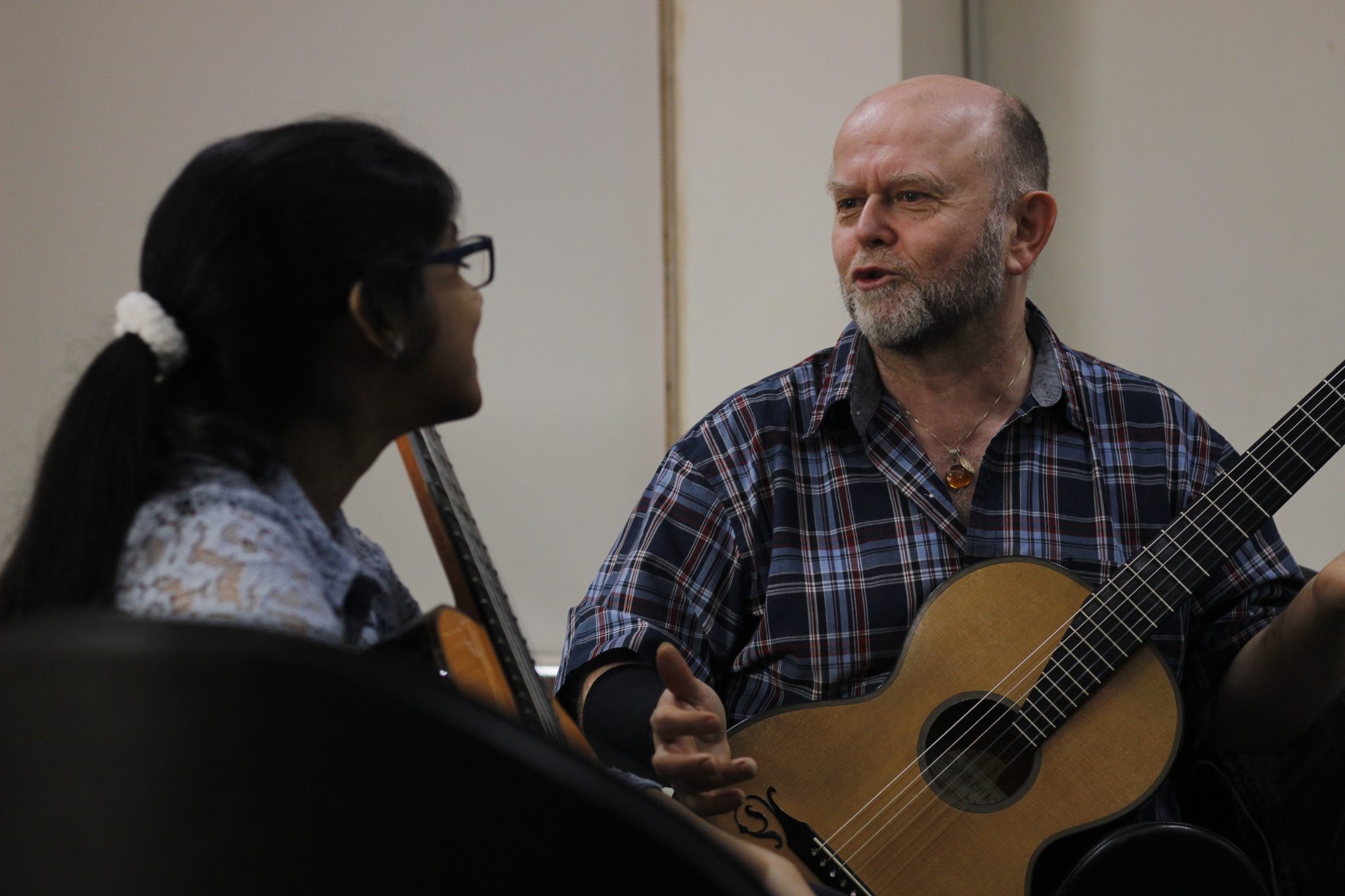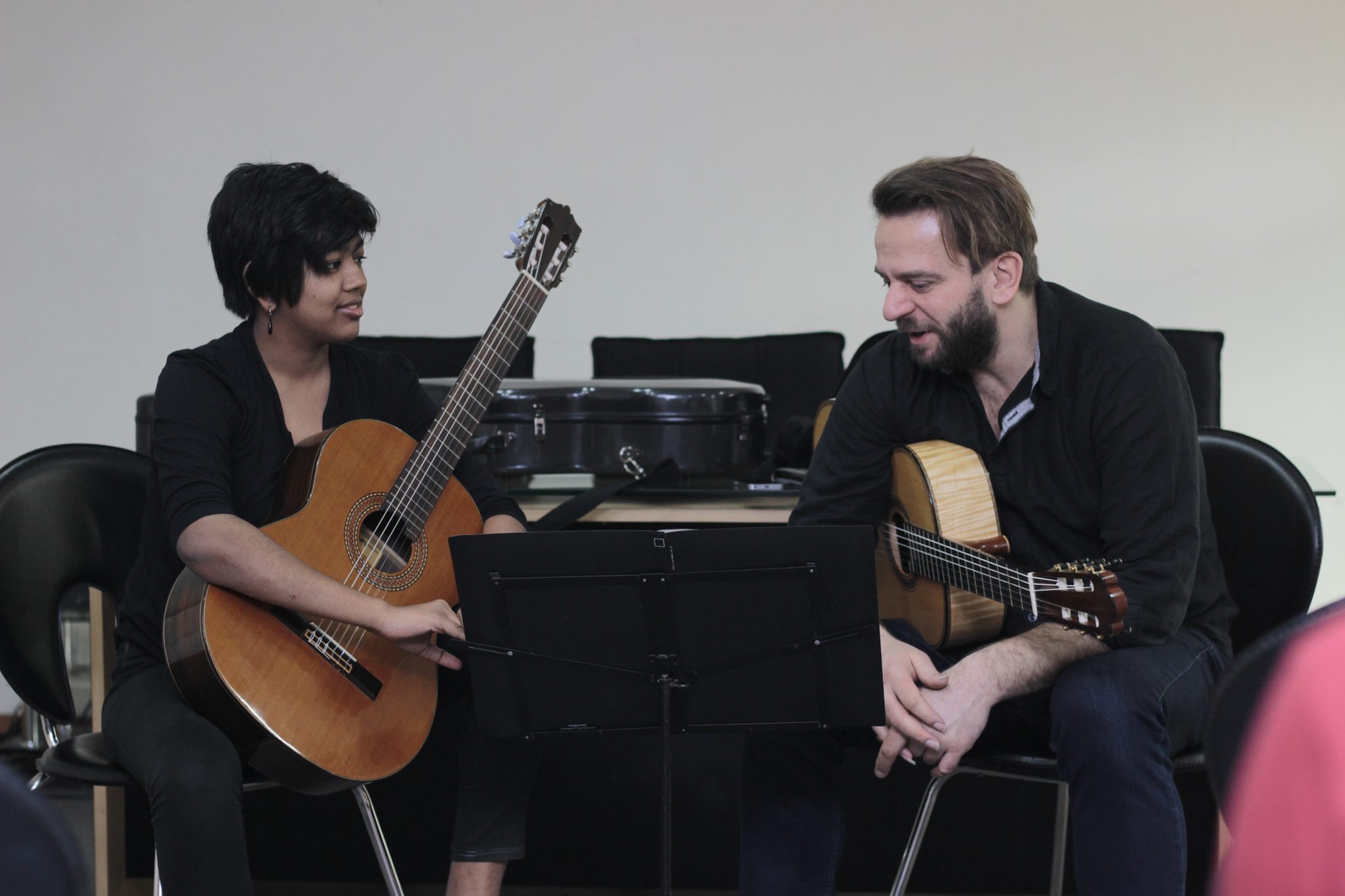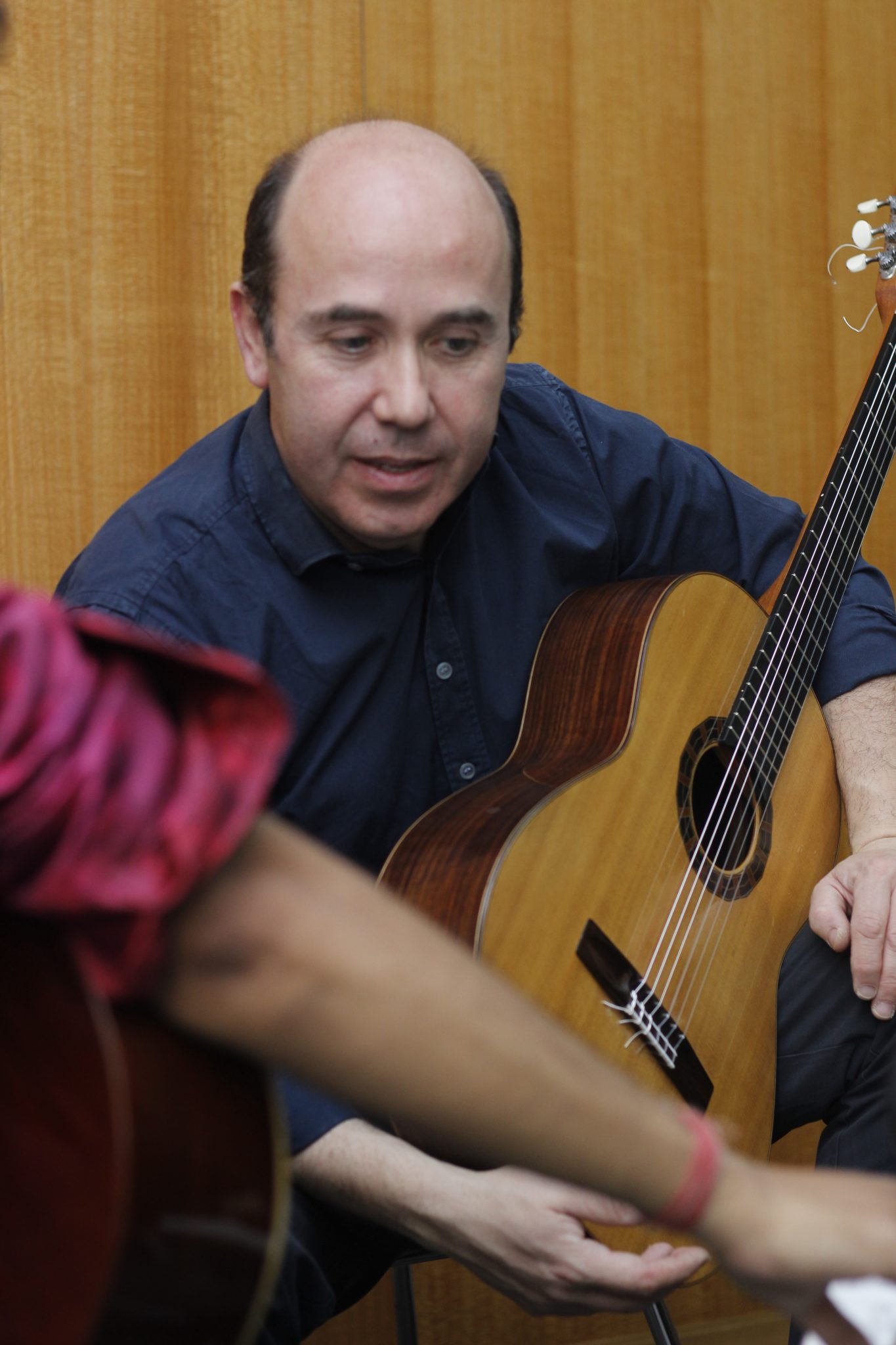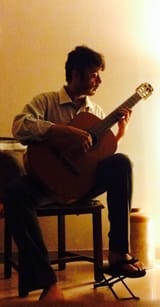High Note

Notes from the Calcutta International Classical Guitar Festival 2017
Annual visit to Kolkata has become a pilgrimage to many who are passionate about Classical Guitar. The participants come from all corners of India, as far as Nagaland and Kerala. Since 2010, each winter, the Indian Guitar Federation and the Calcutta Guitar Society have been organising the Calcutta International Classical Guitar Festival 2017. Organised by a dedicated team of members, the festival has been attracting internationally acclaimed Classical Guitarists all these years.
The high-point of Festival-2017 was the presence of Pavel Steidl, Marcin Dylla, Miguel Trapaga, Johannes Moller and Le Maestrio, and participation of a large team from Nagaland. There were Master classes each day in the morning and post-lunch. Evenings were filled with sold-out concerts, well attended by the very interested audiences of Kolkata.
Members of Pune Guitar Society attended the Calcutta International Classical Guitar Festival 2017 in Kolkata. We took notes during various Master classes of the discussions. These notes, taken in a hurry, have been edited and enhanced to presented here. Some of the points may sound repeated, however they convey the nuances, hence we have presented them as we heard them. We do understand that the notes alone don’t covey the full context. We hope that the readers will nevertheless find these reflections useful while studying. In the least, it gives us a look into how great guitarists think.
The Pune Guitar Society could only attend the masterclasses of Pavel Steidl, Marcin Dylla and Miguel Trapaga and not the masterclasses of Johannes Moller and Le Maestrio. We hope to attend these in the future.

“To make the best sound, one has to be that sound”
– PAVEL STEIDL
Pavel Steidl (born June 24, 1961) is a classical guitarist who was born in Rakovnik, Czechoslovakia (now in the Czech Republic), but has lived in the Netherlands for many years. After winning first prize at the 1982 International Guitar Competition of Radio France in Paris, Steidl began his career as a professional musician. Since he won first prize at the Radio France International Competition in Paris in 1982, he has become one of the most widely celebrated soloists of his generation. In his teaching, Pavel’s approach is encouraging but subtle. For, as he says, “the teacher is not allowed to say everything. I let them play one piece. Each note twice, one staccato, one tenuto, to show what you can do. The possibilities: that’s what I like very much….”
Notes from the Pavel Steidl’s Masterclasses
- Nails which are too long are not good. Nails should be rounded to have shape similar to the shape of the respective finger-tip. Long fingernails generate metallic and monotonic sounds that does not have a potential to create sound with different characters.
Note – Having said this, Pavel did mention that there are players with long nails, who do get a very good tone. But he does not suggest keeping nails very long
- Right hand little finger should be strengthened. You can use it during the practice ‘as if’ it is one of the other fingers. Your brain should be able to command every finger in isolation and with equal control.
- Music can come alive if we think of it together with dance and movements. Gestures made while playing (such as, emphasising rubato, or dissonant node or looking upwards for ‘up-notes’) clearly enhance the quality of performance
Note – Pavel stressed on the importance of thinking ‘movement’ in music. The movement of the body while playing is of utmost importance.
- When one starts playing a piece, the first note is often played slightly longer (..than it’s written duration) because often it establishes a baseline for listeners. It is the floor on which later phrases are built. So listen to yourself and see if playing first note longer enhances your performance.
- Use Abel Carlevaro’s studies – they are very good.
- Damping with RH/LH – Use this piano exercise of long and short notes – Daa-Di-Daa-Di
Note – Learn to damp/stop the sound of a note with the left and the right hand. While practicing this, use long sounds and short sounds in succession as mentioned above.
- ‘Allegro’ doesn’t just mean fast. It also implies ‘fancy’ or ‘happy’. So that feeling should kept in mind and should emerge while playing allegro.
Note – The larger point Pavel was trying to make was – One should relate the ‘tempo’ of a piece to its overall mood/emotion/sentiment/sensibility.
- If a phrase is repeated multiple times in your score, then it should never be played the same (such as a minimalist would) but should be articulated differently each time. Consider how we would ask for a cup of Coffee; first time (Can I have) and then second time (Please can I have) and the third time (Get me that coffee). So, music should reflect such articulations of speech and life.
- ‘Mark’ the high notes when you encounter them first.
Note – Pavel mentioned that the first time you hit a high note, one has to show this in the articulation.
- Learn to play symmetrically, that is strictly keeping time, before you take liberty with asymmetry such as using rubato. There is vast difference when you keep time and execute rubato versus, if you don’t keep time and attempt rubato.
- Fernando Sor says, ‘Press only the notes you want’ as that brings clarity to the play as well as reduces the stress.
- How to play bar with greater control. Pavel showed an exercise where while playing bar, one should not press the finger at a fret on all strings, but the finger should press only the string that need to be played, leaving other strings mute (similar to how a bow would work across the string in case of a violin).
- Sometimes one should practice without the score and at other times one should practice without the instrument. But sometimes one should also practice without the score or the instrument. Sounds like Zen, but what is implied is that, being away from score and instrument helps us reflect on the articulations in our head and thereby enhance the performance.
- Practice slow but move fingers fast between notes. This is because our ear can differenciate between deliberately created interval (which has intent) and an interval arising while moving the fingers (which sounds sloppy). The difference is subtle but noticeable.
Note – Many a times, the overall slow tempo at which one is practicing might slow down the movements of the finger in between the notes at the risk of making some notes longer than how they are written. Avoid this.
- Over the period of last 300-400 years, the ‘protagonist’ in Classical compositions has shifted from God (as in times of Bach and before), to the composer (as in case of Beethoven, Mozart), to the player as an individual (as in case of modern compositions). So while playing compositions of different times, it should be kept in mind as to whose voice are you conveying in the performance.
Note – This is a point made in context of how perceptions and notions about musical compositions has changed over the centuries.
- To make the best sound, one has to be that sound. What Pavel implied here is that one should be mindful of the sound that we are making, have you thought about what it is saying, is it in accordance to what you want to convey.
Note – Pavel explained the importance of ‘shaping’ the sound often with body actions choreographed to the music with some live movements. The sound indeed appears to be enhances. However, it is not clear this really changes the overtones and modulations or it merely creates audio-illusion of modulations because our brain mixes what we see with what we hear.
- Accents are of different types
Note – Pavel was referring to the three types of accents – dynamic, agogic and tonic.
From Wikipedia –
- A dynamic accent or stress accent is an emphasis using louder sound or a stronger articulation, typically most pronounced on the attack of the sound.
- A tonic accent is an emphasis on notes by virtue of being higher in pitch as opposed to higher in volume.
- An agogic accent is an emphasis by virtue of being longer in duration.
- Chiaroscuro – Light and Shadow
Note – Pavel mentioned the importance of the Bel Canto and understanding how singers sing, especially in Italian music. From Wikipedia – Chiaroscuro (music) Chiaroscuro (Italian for “light-dark”) is part of bel canto, an originally Italian classical singing technique in which a brilliant sound referred to as squillo is coupled with a dark timbre called scuro. The overall sound is often perceived as having great depth or warmth.
- Stephen Rak’s exercises – Using 1st joint of right finger and use up and down stroke
Note – Our fingers have three joints. While the 2nd and the 3rd joint are used, we often do not employ the first joint. The first joint is the one where the finger is joined to the palm.
- Recognise the ‘elasticity’ of note. The same note can be played in many different ways generating different overtones.
- When you practice very very slowly, minutest aspects of music become apparent and can be perfected at that slow speed. Pavel practices at a tempo of 40!
- Copying for the sake of learning subtleties is not wrong. When learning articulation of phrases, imitate the masters till you find what you want. Then move on to a new master.
- Stopping the string ‘crisp’ is important. Stop the string in a way, where you are all ready to play the next note. If stopping of the note is not sharp in time, it sounds sloppy and you will have to catch-up with the next note. Again, time gap taken to move the hand can sound different from the deliberately created sound gap.
- Guitar is like a mini orchestra (only if played well). It will of course take enormous practice and thinking for creating variety of sounds, accents and nuances.
- ‘Upward’ moving melody is often aggressive, growing and increasing in volume. And ‘downward’ moving melody is often diminutive and softened.
Note – Here, Pavel is referring to this notion of ‘upward’ movement of the sound. By ‘upward’ he hinted at a psycho/acoustical phenomenon of an ‘uplifting’/’ascending’ sound. The converse being true for the ‘downward’ sound.
- Originally, the ‘Tango’ was a dance for two men ! Gracefulness was not considered only a feminine disposition and that movement and flow has to be expressed in the Tango music.
- Try ‘Guitar Master’ metronome app which has word sounds (select tone=13) rather than using beat sounds. Having words to keep the beats is much better – as is the tradition in Indian music of time-keeping.
Note – Here, a reference was made to the highly developed and sophisticated system of ‘bols’ which are used to convey a ‘bandish’(composition) in a ‘taal’.
- If you play dissonant notes together their contradiction gets lost to the ear. They could be played a little ‘staggered’ (..in very quick succession) to reveal the dissonant interval properly.
Note – Say, you are playing D and a D# together. Play them in a staggered fashion (quickly one after the other) to bring out the dissonant interval fully.
- A better way to tune is to tune with octave notes. Start with two Gs across the strings, then move to two Cs across strings, then move to two As across the strings. This is not perfect but is way to get one kind of temperament.
- The same note can invoke higher overtones or lower overtones depending on how you pluck/play.
Note – Here, Pavel was referring to the different types of upstrokes and downstrokes as well as the hand/wrist position dynamics.
- For guitar, the right hand acts like the mechanics of the piano (i.e. plucking strings is analogous to hammered strings in the case of a piano), while the left hand has to take the role of both left and right hand of the pianist. But unlike a stroke of a piano which has only few variations, right hand stroke can have diverse repertoire.
Note – Pavel was referring to the amount of attention which is required for both right and left hand to be able to create a particular sound.
- Instinct and intuition are two different things. Don’t play with instinct, play with intuition. It is not clear what Pavel means by this – but it could be that instinct is like a reflex, and intuition has more calculated subconscious expression.
Note – This is a highly involved point, but nevertheless one needs to understand the difference between these two words very clearly.
- Left hand is as important in creating accents as right hand. A note can be shaped as much with left hand fingers, as it can be with right-hand finger. This aspect is not very recognised (although Aguado opens this subject up in his treatise).
- The neck of guitar is not a passive part, it also resonates. So pay attention to how that ‘feels’ as well. If you hold on to the neck tightly, you are killing that resonance. Ideally practice without using left-hand thumb or not pressing it hard on the neck.
- Every force or energy in the left hand that is ‘going up’ or ‘outwards’ is a waste – Do not use thumb force. All that energy should go downwards ‘onto’ the string and neck from left-hand fingers and arm.
Note – This has to be understood in the context of right hand fatigue and right hand note articulation.
- Practice playing bar with finger touching only one string at a time. Pressing a string which is not needed is a waste of energy – and your fingers will stress-out.
- Pay attention to the power of overtones..The richness the guitar is often in the overtones that are created.
- Would you prefer to play a level 10 score (complexity level) at level 3 (performance level), or play a level 3 score (complexity level) at level-10 (performance level)
Note – Pavel was indicating that one should take up music that one can handle in terms of comprehension, execution and communication. It is much better to play an easier piece with great finesse rather than playing impressive score unimpressively.

“Often a small thing is blocking a larger piece. Locate it” – MARCIN DYLLA
Marcin Dylla was born in Chorzow, Poland, and took lessons at the Ruda Slaska Music Conservatory. He attended the Music Academy of Katowice, and academies in Basel, Freiburg and Maastricht. Marcin Dylla is a rare phenomenon in recent history of Classical Guitar. Many music critics, connoisseurs and music lovers certify that Marcin Dylla is among the world’s elite of classical guitar players. He has earned this position, among others, to unparalleled number of awards including 19 First Prizes from 1996-2007 at the most prestigious international music competitions around the world. His last triumph was the Gold Medal of the ‘2007 Guitar Foundation of America International Competition’ in Los Angeles known as the most prestigious guitar contest in the world followed by tour of over 50 cities in North America, Mexico and Canada during 2008-09 season, live recital video recording for Mel Bay Publications and CD recording for Naxos that reached the Naxos ‘Top 10 Best Selling Albums’ in September 2008. His live recital DVD “Wawel Royal Castle at Dusk” was nominated for 2010 Fryderyk Award (equal to American Grammy) in the category of Solo Classical Music Album of the Year.
Notes from Marcin Dylla’s Masterclasses
- Practicing a lot without ‘thinking’ is dangerous because the muscle memory gets built and adapting to changes becomes difficult later on. Practice slowly and mindfully, a diverse range of tunes.
- Learning music is repeating endlessly while doing critical thinking at every repeat.
Note – This was very evident in Marcin’s master classes. Marcel would immediately try out a phrase 5 – 6 times, each time getting better, till he got the phrase to convey what he wanted it to.
- Long phrases can be articulated with a single ‘impulse’.
Note – We think what Marcin was trying to say was that long phrases need to be played like one ‘idea’ or one ‘entity’ in a way that singers play a string of notes in a one breath.
- If there are similar articulations in the piece you are practicing, but they are scattered far apart (which often is the case), then get them together while practicing.
- Conversation as a metaphor.
Note – Marcin was talking of thinking of phrases which occur one after the other as a conversation between different voices. Thinking orchestrally helps in articulating different ‘conversations’ between instruments/voices.
- Don’t stress always on the downbeat.
Note – For example, in a 4/4, we know that the downbeat is the first beat and it is supposed to be accented/stressed. This is true as a rule but there are many exceptions to this, so do not do this every time.
- Look at the right hand for understanding the muscle movement. Work on finger ‘preparation’. Watch your fingers – the visual feedback from right hand and left hand is important. Make fingers do what you want them to do.
- Importance of ‘fingering’ as an exercise to break technical blocks. Dynamics, sound Quality and articulation are directly related to ‘fingering’.
- Music becomes heavy because of predictable rhythm. Think lines/phrases.
Note – Marcin is referring to the ‘horizontal’ character of the melody/harmony
- Break a phrase into musically appealing groups of 2-3 notes to practice. Work on the expression of micro-pieces (within a section/phrase), small twists and turns.
- Good music is about building expectations. It sounds good when our expectations are met and we feel rewarded. Expectations can be stretched with more and more complicated phrases – in this case, the reward is also greater
Note – Here, Marcin was referring to building a narrative or storytelling skills.
- If there is a ‘big’ problem, then usually it is something small which is causing it. The small thing is generally harder to determine. Breakdown gestures into smaller chunks to identify what is blocking the overall musical intent.
- What is really the problem? It’s usually a small thing that is blocking a larger thing. Challenge is to analyze, identify and work on it.
Note – Here, Marcin takes his paradigm of problem solving to another level. This problem solving advice is also the mantra for problem solving in a myriad of domains including engineering, design, architecture and so on.

“Being good once is not the same thing as not being ever bad” – MIGUEL TRÁPAGA
Born in Cantabria in 1967, Miguel Trápaga has won top prizes in several guitar competitions, including the XVIth Andrés Segovia International Guitar Competition, Palma de Mallorca, the IIIrd Great Lakes Competition, Oberlin, Ohio, and the XIIth International Solo Guitar Competition, Guitar Foundation of America. He has performed in broadcasts for Spanish National Radio, Antena 2 of Portugal, the BBC and elsewhere and has recorded six compact discs. Currently a teacher at the Royal Conservatory of Music in Madrid, he has given masterclasses in Spain and abroad (Sibelius Academy, Frederic Chopin Academy in Warsaw, Melbourne University), and has performed in the main concert halls and theatres in Spain, with concert tours of Europe, Australia, Africa, Latin America, Asia, Canada and he United States. He has performed with numerous orchestras, including the National Philharmonic of Ukraine, the Seville and Madrid Symphony Orchestras, and the Canberra Symphony Orchestra. With the Simon Bolívar Symphony Orchestra of Venezuela, he performed Leo Brouwer’s Concierto de Benicàssim conducted by the composer.
Notes from Miguel Trapaga’s Masterclasses
- The composition one is playing is ‘going’ some place. That direction should be in the mind while playing.
Note – Miguel was referring to the clarity which one should have about what is going to happen next in the piece.
- Learn to read music well. That will save time and you will learn much faster than otherwise. Use your visual memory more than musical memory or muscle memory – play by reading the score.
Note – Are you using musical memory or visual memory? If you can start playing the score from any place without starting earlier phrase, then you are reading from the score – else you are reading based on your musical memory.
- Spanish music often has contrasts in moods. It swings between for example, calm and aggressive.
- The word ‘Rubato’ means stone – put and lift. If you put it down you will have to lift it later. It is the same with time keeping. If you ‘steal’ time now, you have to give it back later. Stick to a tempo. Rubato sounds good only if it is an exception.
- ‘Vibrato’ is played to sustain a note longer. After you strike a note, first let the overtones roll out and the ‘vibrato’ should come late when sound is dying out.
Note – though Miguel demonstrated this, you need to try this out to see how it works.
- If the right hand little finger is ‘out’ that means the hand has tension. Little finger should roll with other fingers to avoid building stress in the hand.
- ‘Articulation’ is important, in fact it is the essence. Articulation is a way to join two notes, the way we string words together in language.
- Playing fast is not same as being rhythmic. We often confuse playing fast with playing in time/rhythm.
- The time the finger spends with the string while plucking/playing it can create different effects. Some notes need longer contact with the string than other notes.
- Up and Down strokes are not just strokes, they create different overtones. Upstroke sound creates higher overtones and a happier and lighter sense. Down stroke creates lower overtones and heavier/sadder sense.
Note – The string can be plucked up, down or sideways – try and see how they create different sounds.
- One should play slow because that gives one time to think about what kind of sound one wants to reach.
- Left hand – Since the third finger is hard to control, use that as reference, and rest of the fingers will fall in place.
- Practice sight reading beyond the 5th position. It should not be that sight reading is easy only in the first few positions.
- Sometimes, just move the fingers and not the hand along with them. At other times, move the hand as well.
- Balance between trebles and bass can be managed by the right hand.
- Practice arpeggios well.
Note – The fluidity in playing phrases across strings can be achieved by practicing arpeggios.
- Keep the left hand close to the fretboard at all times.
- Listen to yourself while practicing. At all times, try and listen to yourself.
- Practice in dark at times, to achieve full control over your playing.
- Left hand – each finger needs to be trained to act independently as per will.
- Being good once is not the same thing as not being ever Practice till you are never bad.
The Pune Guitar Society thanks Pavel Steidl, Marcin Dylla and Miguel Trapaga for this invaluable guidance and insight. Thanks to the Indian Guitar Federation for the organization and creating this wonderful opportunity to interact with these masters.
The article was edited and compiled with Pradeep Gothoskar of the Pune Guitar Society.





